________________
sadguru). They have since organised a chain of institutions called 'temples of
knowledge' (jnaan mandir) throughout the world for the promotion of his Jain teachings.
He has become best known as the spiritual mentor of Mahatma Gandhi, whom he met in 1891 after Gandhi had been in England studying law. The timing of this encounter was significant, for Gandhi was facing a personal spiritual crisis, was uncertain of his faith, and considering conversion to Christianity. Srimad Rajchandra gave Gandhi an anchor in the values of Indian religious traditions, and it was Rajchandra's example which led Gandhi to follow the way of 'non-violence' (ahimsaa), utilising it as the main weapon with which to win independence for India. Throughout his life, Rajchandra expressed the truths that arose from his spiritual life and those who were close to him knew that they were in the presence of a great soul. He died in 1901 at Rajkot (Gujarat). Kanji Swami (1889 to 1980 CE): Born in Gujarat in 1889, Kanji Swami was initiated as a Sthanakvasi ascetic at the age of 24. His depth of knowledge and speaking skills were such that he was honoured with the title of the 'mountain of light' (koh-inoor) of Kathiawar. During his scriptural studies he was highly impressed by the 'Essence of Doctrines' (Samaya Saara) of Kundakunda, which led him to study the books of Banarasidass, Todarmal and Rajchandra. He felt the 'soul-oriented' Digambar path was the true path and, in 1934, he proclaimed himself a Digambar layperson and began preaching Kundakunda's teaching.
Gradually, the number of his followers, both Svetambars and Digambars, grew to many thousands. His sermons encouraged his followers to adopt a habit of regular personal study and the distribution of Jain literature, and they impressed upon his followers the view that rituals and attire have no meaning without a proper understanding and the right frame of mind.
Many remarkable incidents have been associated with him, which illustrate his charismatic personality. His followers have popularised the devotional doctrine of the "Living Tirthankara of Mahaavideha' (Simandhar Swami). Jain geography describes Mahaavideha as a continent of the Jambudvipa region, where people live and where there is always at least one living tirthankara, and Simandhar Swami is one of the present living tirthankaras on this continent.
The main centres for the propagation of Kanji Swami's teachings today are Songadh in Gujarat and Jaipur in Rajasthan, though there are outposts in Nairobi, London and the United States. Kanji Swami died in 1980, in Bombay.
Jains have remained a respected community in India and have been prominent in the economic life of India. They have contributed significantly to Indian culture and heritage, and are well known for their philanthropic and welfare activities, for animals as well as people. Jain values are highly regarded and attract support from Jains as well as from the wider community.
The above account of popular support is based on vernacular literature such as Atmanandji (1988), Devluck ed. (1985), Doshi (1979), Duggadh (1979), Khusalchandramuni (1990), Modi (1988), Shah R. (1992), Vaid (1980) and articles from the Jain (1982-1989).
74




